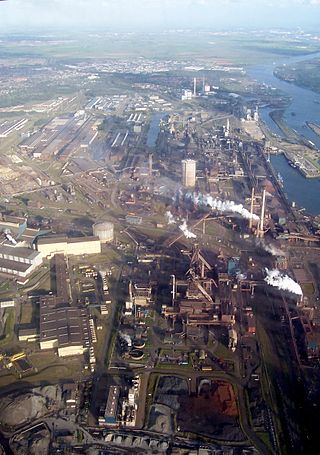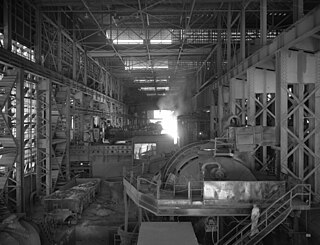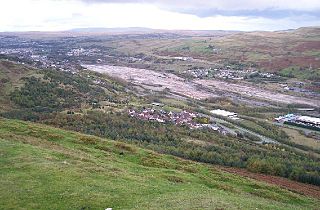Related Research Articles

A steel mill or steelworks is an industrial plant for the manufacture of steel. It may be an integrated steel works carrying out all steps of steelmaking from smelting iron ore to rolled product, but may also be a plant where steel semi-finished casting products are made from molten pig iron or from scrap.

An ironworks or iron works is an industrial plant where iron is smelted and where heavy iron and steel products are made. The term is both singular and plural, i.e. the singular of ironworks is ironworks.

The Jones and Laughlin Steel Corporation, also known as J&L Steel or simply as J&L, was an American steel and iron manufacturer that operated from 1852 until 1968. Beginning as the American Iron Company, founded in 1852 by Bernard Lauth and Benjamin Franklin Jones, a few miles south of Pittsburgh along the Monongahela River. Lauth's interest was bought in 1854 by James Laughlin. The first firm to bear the name of Jones and Laughlin was organized in 1861, and headquartered at Third & Ross in downtown Pittsburgh.
ArcelorMittal South Africa is part of the steel company Arcelor-Mittal. The company was originally Iscor Ltd., a South African parastatal steel company. It was founded in 1928 and was first listed on the JSE Securities Exchange in 1989.

Geneva Steel was a steel mill located in Vineyard, Utah, United States, founded during World War II to enhance national steel output. It operated from December 1944 to November 2001. Its unique name came from a resort that once operated nearby on the shore of Utah Lake.

Koninklijke Hoogovens known as Koninklijke Nederlandse Hoogovens en Staalfabrieken (KNHS) until 1996 or informally Hoogovens. was a Dutch steel producer founded in 1918. Since 2010, the plant is named Tata Steel IJmuiden.
IISCO Steel Plant of Steel Authority of India Limited is an integrated steel plant located at Burnpur, a neighbourhood in Asansol city, in the Asansol subdivision of Paschim Bardhaman district, West Bengal, India.

The Inland Steel Company was an American steel company active in 1893–1998. Its history as an independent firm thus spanned much of the 20th century. It was headquartered in Chicago at the landmark Inland Steel Building.

Kaiser Steel was a steel company and integrated steel mill near Fontana, California. Industrialist Henry J. Kaiser founded the company on December 1, 1941, and workers fired up the plant's first blast furnace, named "Bess No. 1" after Kaiser's wife, on December 30, 1942. Then in August 1943, the plant would produce its first steel plate for the Pacific Coast shipbuilding industry amid World War II.
The Park Gate Iron and Steel Company was a British company that smelted iron ore and turned it into rolled steel and semi-finished casting products. Its works was at Parkgate, South Yorkshire on a triangular site bounded on two sides by the main road between Rotherham and Barnsley (A633) and the North Midland Railway main line between Rotherham Masborough and Cudworth. It also operated ironstone quarries in Northamptonshire and Leicestershire.
Before 1800 A.D., the iron and steel industry was located where raw material, power supply and running water were easily available. After 1950, the iron and steel industry began to be located on large areas of flat land near sea ports. The history of the modern steel industry began in the late 1850s. Since then, steel has become a staple of the world's industrial economy. This article is intended only to address the business, economic and social dimensions of the industry, since the bulk production of steel began as a result of Henry Bessemer's development of the Bessemer converter, in 1857. Previously, steel was very expensive to produce, and was only used in small, expensive items, such as knives, swords and armor.

The Ravenscraig steelworks, operated by Colvilles and from 1967 by British Steel Corporation, consisted of an integrated iron and steel works and a hot strip steel mill. They were located in Motherwell, North Lanarkshire, Scotland.

The Tennessee Coal, Iron and Railroad Company (1852–1952), also known as TCI and the Tennessee Company, was a major American steel manufacturer with interests in coal and iron ore mining and railroad operations. Originally based entirely within Tennessee, it relocated most of its business to Alabama in the late nineteenth century, following protests over its use of free convict labor. With a sizable real estate portfolio, the company owned several Birmingham satellite towns, including Ensley, Fairfield, Docena, Edgewater and Bayview. It also established a coal mining camp it sold to U.S. Steel which developed it into the Westfield, Alabama planned community.
The Duluth Works was an industrial steel and cement manufacturing complex located in Duluth, Minnesota, United States, in operation 1915 to 1987. The complex was operated by the United States Steel Corporation. Officially, the plant's purpose was to supply the growing Midwest with steel finished products. Unofficially, they were built as part of a "gentleman's agreement" between U.S. Steel and the State of Minnesota to not impose hefty iron ore taxes on U.S. Steel in exchange for a fully integrated steel plant within Minnesota, whose mines furnished 80% of the ore to U.S. Steel. The combined works of the steel and cement plant were the largest employers in Duluth and the fourth largest industrial complex in Minnesota.

Ebbw Vale Steelworks was an integrated steel mill located in Ebbw Vale, South Wales. Developed from 1790, by the late 1930s it had become the largest steel mill in Europe. It was nationalised after World War II. As the steel industry changed to bulk handling, iron and steel making was ceased in the 1970s, and the site was redeveloped as a specialised tinplate works. It was closed by Corus in 2002, but is being redeveloped in a joint partnership between Blaenau Gwent Council and the Welsh Government.

The Iron and Steel Industry in Scunthorpe was established in the mid 19th century, following the discovery and exploitation of middle Lias ironstone east of Scunthorpe, Lincolnshire, England.
In 2022, the United States was the world’s third-largest producer of raw steel, and the sixth-largest producer of pig iron. The industry produced 29 million metric tons of pig iron and 88 million tons of steel. Most iron and steel in the United States is now made from iron and steel scrap, rather than iron ore. The United States is also a major importer of iron and steel, as well as iron and steel products.

The US iron and steel industry has paralleled the industry in other countries in technological developments. In the 1800s, the US switched from charcoal to coal in ore smelting, adopted the Bessemer process, and saw the rise of very large integrated steel mills. In the 20th century, the US industry successively adopted the open hearth furnace, then the basic oxygen steelmaking process. Since the American industry peaked in the 1940s and 1950s, the US industry has shifted to small mini-mills and specialty mills, using iron and steel scrap as feedstock, rather than iron ore.
Skinningrove steelworks is a steel mill in Skinningrove, North Yorkshire, England. The business was formed in 1874 as the Loftus Iron Company, after a liquidation of the company reformed in 1880 as the Skinningrove Iron Company. The works expanded from producing only pig iron to include steel production in the early 20th century, with mills specialising in long products including railway rail. As part of the business the company constructed a jetty at Skinningrove, and owned an ironstone mine in Loftus.

The Société des aciéries de Longwy was a steelworks located in Longwy, Meurthe-et-Moselle, France.
References
- ↑ "About Us". Columbia Steel Cast Products LLC. Retrieved 2023-10-18.
- ↑ "Steel foundry on the Pacific Coast". Iron Trade Review. Vol. 61, no. 12. 20 September 1917. p. 597.
- ↑ "Here and There in Industry". Iron Trade Review. Vol. 66, no. 8. 19 February 1920. p. 576.
- ↑ "(unreadable title)". Iron Trade Review. Vol. 67, no. 1. 1 July 1920. p. 29.
- ↑ "Columbia Steel Corporation". Commercial and Financial Chronicle. Vol. 116, no. 3004. 20 January 1923. p. 301.
- ↑ "Columbia Steel Purchases Torrance, Cal. Plant". Iron Trade Review. Vol. 72, no. 16. 19 April 1923. p. 1134.
- ↑ "New Utah Blast Furnace Now in Operation". Iron Trade Review. Vol. 74, no. 20. 15 May 1924. p. 1287.
- ↑ "Utah Coal Mining Feels Awakening in Utah Coal Mining". Coal Age. Vol. 22, no. 15. 12 October 1922. p. 596.
- ↑ "Utah Line Authorized". The Traffic World. Vol. 31, no. 4. 27 January 1923. p. 202.
- ↑ "UtahRails Maps". Utah Rails. Retrieved 2023-10-18.
- ↑ Kinney, S.P. (1930). Effect of Sized Ore on Blast-Furnace Operation, Technical Paper 459. U.S. Department of Commerce, Bureau of Mines.
- ↑ "Columbia Steel Corp., San Francisco". Commercial and Financial Chronicle. Vol. 121, no. 3146. 10 October 1925. p. 1793.
- ↑ "Industrial Business Changes". Iron Trade Review. Vol. 79, no. 8. 19 August 1926. p. 484.
- ↑ "Columbia Steel Corp". Commercial and Financial Chronicle. Vol. 123, no. 3206. 4 December 1926. p. 2906.
- ↑ "Storms Hold Back Work". Iron Trade Review. Vol. 79, no. 24. 9 December 1926. p. 1522.
- ↑ "Build Sheet Mill at Golden Gate". Iron Trade Review. Vol. 74, no. 21. 22 May 1924. p. 1373.
- ↑ "Columbia Becomes Sole Coast Sheetmaker". Iron Trade Review. Vol. 79, no. 23. 2 December 1926. p. 1451.
- ↑ "Steelworks and Rolling Mills on Pacific Coast". Iron Trade Review. Vol. 83, no. 26. 27 December 1928. p. 1643.
- ↑ "Enlarges Coking Capacity". Iron Trade Review. Vol. 80, no. 25. 23 June 1927. p. 1618.
- ↑ 28th Annual Report of the United States Steel Corporation. 1929. p. 7-8.
- ↑ 29th Annual Report of the United States Steel Corporation. 1930. p. 38.
- ↑ "West Coast Steel Mill". Steel. Vol. 116, no. 14. 2 April 1945. p. 120.
- ↑ "Blast Furnace Capacity by Plant Location and Operating Company". Steel. Vol. 129, no. 14. 1 October 1951. p. 123.
- ↑ "Construction Underway at Columbia's Pittsburg Mill". Organized Labor. 10 August 1946. p. 5.
- ↑ "The Doors Open at New Coast Mill". U.S. Steel News. Vol. 14, no. 1. U. S. Steel. January 1949.
- ↑ "Columbia Starts Expansion". Steel. Vol. 128, no. 1. 1 January 1951. p. 434.
- ↑ 50th Annual Report of the United States Steel Corporation. 1951. p. 19.
- ↑ 50th Annual Report of the United States Steel Corporation. 1951. p. 38.
- ↑ "Army Reopens West Coat Foundry". Steel. Vol. 131, no. 7. 18 August 1952. p. 175.
- ↑ "Watch the West Coast". Steel. Vol. 142, no. 18. 5 May 1958. p. 54.